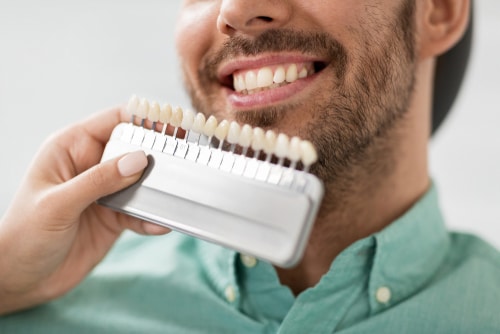Veneers
 Dental veneers are the popular solution for people with a misshaped tooth, gap between teeth, and chipped tooth. Veneers are custom-made, wafer-thin shells that use materials that resemble the color of the teeth. They are designed to camouflage the exterior of the tooth to enhance your looks. The veneers are either fitted or bonded to the teeth, and these shells can be customized to improve the appearance of the wearer.
Dental veneers are the popular solution for people with a misshaped tooth, gap between teeth, and chipped tooth. Veneers are custom-made, wafer-thin shells that use materials that resemble the color of the teeth. They are designed to camouflage the exterior of the tooth to enhance your looks. The veneers are either fitted or bonded to the teeth, and these shells can be customized to improve the appearance of the wearer.
There are two types of veneers:
1. Porcelain Veneer
This type of veneer is custom-made to fit the tooth. The porcelain veneer provides the following benefits:
- It does not stain easily.
- It only requires less tooth enamel to be removed as compared with cap or crown.
- It provides a natural-looking exterior.
- It is tough enough to withstand wear and tear to last for a long time.
2. Composite Veneers
This type of veneer is bonded to the tooth. It is made from filling material that resembles the color of the teeth. Composite veneers offer the following benefits:
- They are easy to fix when they incur damage.
- They are less expensive than porcelain veneers.
- You don’t need to always visit your dentist when you have composite veneers.
- It only needs to remove less tooth enamel than porcelain veneers.
Composite veneers are not as strong and long-lasting as porcelain veneers, but they can be repaired quickly.
Benefits of Dental Veneers
If you want to have a captivating smile, you may want to give dental veneers a serious consideration. Dental veneers can help you:
- Gain the confidence to smile at people more and appear amicable at all times.
- Eliminate the large gap or uneven spaces between your teeth, which could give a feeling of uneasiness.
- Turn back the worn or chipped tooth to its original state and make them as good as before.
- Make your teeth white once more when bleaching no longer works.
- Can fix or straighten uneven, misaligned, or irregularly shaped teeth.
- Veneers present a conservative way of altering the shape and color of the teeth that do not require you to go through extensive tooth shaping before the procedure.
Preparation Before Getting Your Veneers
Your teeth and gums need to be healthy before you can accept the veneers. Your dentist needs to conduct a thorough dental checkup to make sure if you have other dental problems. The dentist must treat your other dental issues first before you can get your veneers.
If you are someone who grinds or clenches her teeth, veneers may not be the most suitable choice for you. The thin veneers may break or chip from the grinding or clenching action that you do with your teeth. If you are keen on getting your veneers even though you have the habit of grinding or clenching your teeth, your dentist may recommend wearing a dental night guard when you sleep. The night guard is made of plastic.
Removing a little tooth enamel is necessary. It is impossible to undo this process once it has started. The good news is you only need to sacrifice a minute amount of your tooth enamel to get your veneers.
Veneers may loosen after having them for so many years. When that happens, you may need to change your veneers for a new one. You need to discuss everything with your dentist regarding your dental care. You may ask other options or alternatives that may fit your preference more.
Here’s a list of procedure for getting a dental veneer.
1. Diagnosis and Treatment of Other Dental Issues
This first step requires your cooperation and active participation. You need to make your dentist understand the kind of result that you expect or trying to achieve when you wear veneers. Tell your dentist everything about your plan so he can give you the most suitable solution.
Your dentist will examine your teeth thoroughly to check for any other dental issues that may only turn worse if they are not addressed appropriately before having your veneers. Your dentist still needs to determine the type of dental veneers that are suitable for you. He will discuss the procedure and the limitations that you need to understand.
You may need X-rays of your teeth per your dentist’s recommendation. He may also create an impression of your teeth.
2. Preparing Your Teeth
Your dentist will need to scrape off around 0.5 millimeter of enamel from the surface of the tooth that needs a veneer. The said amount is equal to or nearly the same as the thickness of the veneer that will be added to the tooth’s surface.
Before scraping the enamel, you and your dentist must discuss the need to apply a local anesthetic to the affected area. Your dentist also needs to create an impression or model of your teeth. The model will be sent to a dental lab that will construct your veneer. It usually takes between two and four weeks before your dentist receives the finished veneer.
3. Bonding or Fitting the Veneer
The dentist will temporarily put your veneer on your teeth to check if the color is right and whether it fits. Your dentist may need to repeatedly fit, remove, and trim the veneer until he achieves the perfect fit. Your dentist can adjust the color of the veneer using the right shade of cement.
Your dentist needs to clean, polish, and etch your tooth before you receive the veneer. A special cement is then applied to the veneer before it gets fitted to the tooth. When the veneer is placed properly on the tooth, a special light beam will be applied to the veneer. The light beam activates the chemicals in the cement and makes it set quickly.
The dentist will clean the excess cement, evaluate your bite, and make some adjustments when needed. When your dentist tells you to return on a certain date for your check-up, make sure to return. He needs to see the reaction of your gums to the veneer and also to check whether everything is still in place.
The veneers usually last between seven and fifteen years. Make sure to follow the instructions of your dentist regarding the care and maintenance as well as the good oral hygiene that you need to follow. Don’t miss any dental appointments to make your teeth last longer.
